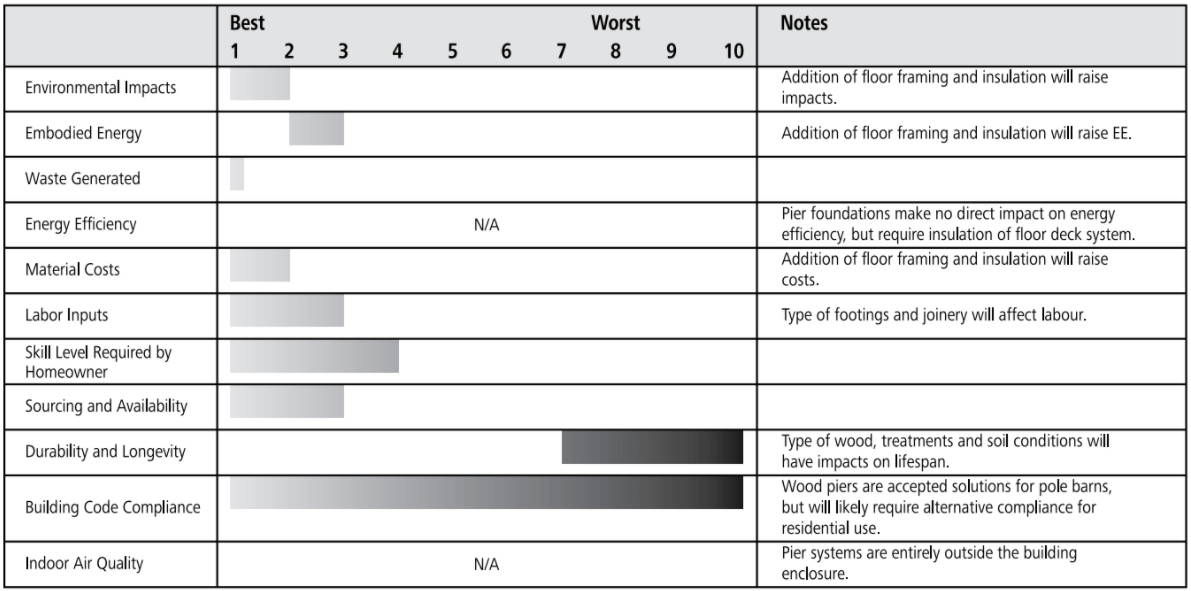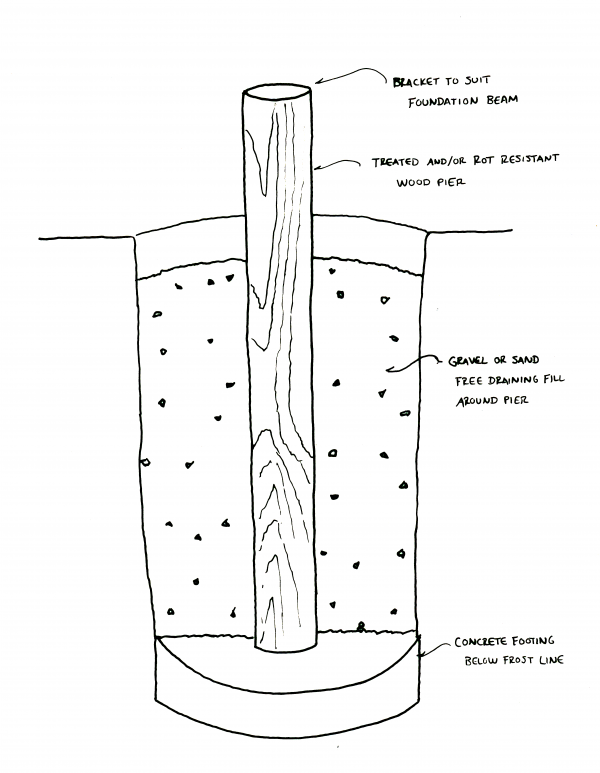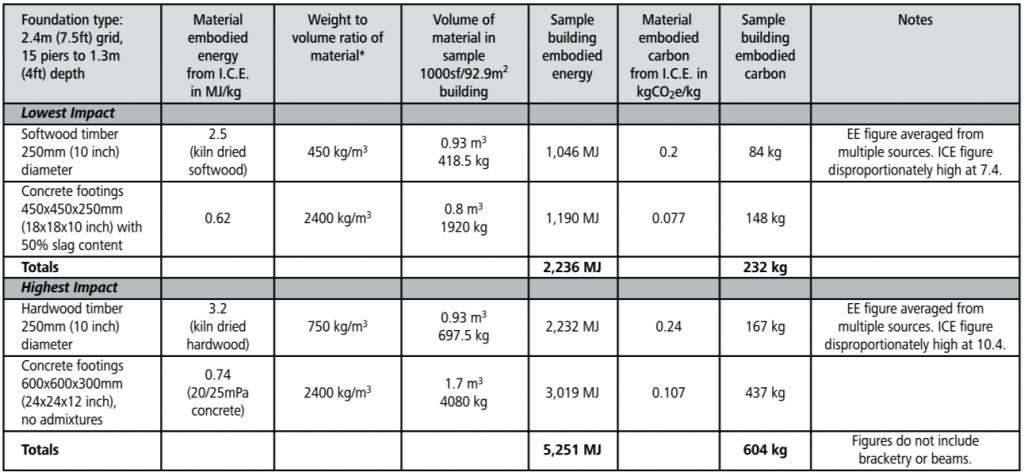Wooden piers
FOUNDATIONS: MATERIALS ENCYcLOPEDIA
Applications for this system
Piers
Basic materials
Large timbers, either milled or round
Treatment for the wood below grade
Ratings Chart for wooden pier foundation

The ratings chart shows comparative performance in each criteria category. Click on the tabs below for detailed analysis of each criteria.
- HOW THE SYSTEM WORKS
- ENVIRONMENTAL IMPACTS
- WASTE
- EMBODIED CARBON
- ENERGY EFFICIENCY
- MATERIAL COSTS
- LABOUR INPUT
- SKILL LEVEL REQUIRED
- SOURCING & AVAILABILITY
- DURABILITY
- CODE COMPLIANCE
- INDOOR AIR QUALITY
- RESOURCES
- FUTURE DEVELOPMENT
wooden pier System

Wooden members of an appropriate size are used to support a floor deck above grade. Typically, a hole is drilled or excavated to a depth below the frost line and a gravel base and/or concrete footing are placed to receive the pier. The excavation around the wooden pier is then backfilled with a well-draining sand/gravel mixture and tamped-in lifts to locate and secure the pier.
The tops of the piers are trimmed to the desired height above grade and prepared to support the floor beams. Attachments between pier and beam can range from traditional timber-framing joinery to notch-and-bolt systems to welded metal plates. These choices will be dictated by budget, skill level and engineering and code requirements.
Environmental Impact Rating
Harvesting — Negligible to Low
Site-harvested timber can have negligible impacts. Locally harvested timber is available in many regions and if sustainable forestry practices are used impacts can be very low. Use of third-party certified timber can help to ensure that impacts are minimal.
Manufacturing — Negligible
Large round timber can be used without any process beyond bark removal. Squared timbers require a minimal amount of mechanical processing. Use of third-party certified timber can help to ensure that impacts are minimal.
Transportation — Negligible to high
Sample building uses 418.5 – 697.5 kg of wooden piers:
0.63 – 1.05 MJ per km by 15 ton truck
0.4 – 0.66 MJ per km by 35 ton truck
Sample building uses 1920 – 4080 kg of concrete:
2.88 – 6.12 MJ per km by 15 ton truck
1.8 – 3.84 MJ per km by 35 ton truck
Timber is a heavy and high-volume material to transport and impacts will rise proportionally with distance traveled. Widespread regional production can help to minimize transportation requirements.
Installation — Negligible
The use of timber pier foundations can eliminate the need for intensive excavation of the building site, mitigating one of the highest impacts on the local ecosystem.
Waste: Negligible
Biodegradable/Compostable — All untreated wood offcuts.
Recyclable — Metal fasteners.
Landfill — Wood offcuts with treatments, containers for treatment materials.
Chart of Embodied energy & carbon
Energy Efficiency: n/a
Wooden piers are typically outside the building enclosure. As such, they don’t have a direct impact on energy efficiency.
Piers are often used to build raised floor decks, in which the floor of the building is elevated above grade and the bottom side of the floor system is exposed to the air. When decoupled from the ground, the underside of a floor system is exposed to greater fluctuations in temperature in cold climates and an insulation strategy must be chosen to deal with this exposure. In such cases, the floor insulation should be at least as thick as the walls, and the same attention must be paid to avoiding thermal bridging and air leakage.
Material costs: very Low
If metal bracketry and fasteners are being used to connect piers to beams, these may end up being the most expensive element. The use of off-the-shelf bracketry will help keep these costs lower than specialty or custom-welded brackets.
Labour Input: very low
The majority of the labor involved in a wooden pier foundation is in the excavation and backfilling. Using a natural preservation method will add time to the process. Hand-cut joinery will usually be more labor intensive than bracketry.
Skill level required for homeowners: low to moderate
Most forms of joinery used to attach piers to beams are straightforward and well within the abilities of most owner-builders. Grid layouts for pier placement are also straightforward.
Sourcing & availability: Easy
Timbers suitable for piers are locally available in most regions. Check for availability of off-the-shelf bracketry for joining piers to beams. Local welders will be able to fabricate suitable brackets, and in some cases these may be less expensive than commercially sourced components.
Durability: low
In most vernacular traditions, buildings with very low embodied energy and materials that were easily reused or compostable served their purpose and were not expected to endure forever. A building made with all natural and recycled materials and largely human embodied energy has little “environmental debt” to repay, so longevity is not as important on a planetary scale as with other, more intensive buildings. If longevity becomes a personal choice rather than an environmental one, it is up to the owner or builder to decide.
Wood in contact with soil is very prone to rot failure, so the key to viable wood pier foundations is reducing the chance of short-term susceptibility to rot. Choosing a naturally rot-resistant wood is the first step in designing a wood pier foundation. Cypress, redwood, cedar, locust and white oak are among the available species that are appropriate. Methods of preserving or treating the wood should also be considered; there are many, from very natural to highly toxic.
No method of treating wood will guarantee a long lifespan below grade, but in the right conditions it may help to achieve a lifespan that is adequate for the intended purpose of the building. Clay/mud coatings, charring, creosote and chemical pressure-treating are among the treatments that have, in some cases, helped wood last longer below grade. New methods of heat-treating and silica impregnation show promise.
The most vulnerable portion of a wooden pier is the junction with grade, which will see frequent wetting and drying cycles and be most susceptible to damage from fungi, insects and even animals like porcupines. Protection for this area can include wide overhangs from the floor system above and a generous circumference of gravel fill around the pier to encourage quick drainage and discourage plant growth.
Even well-built wooden piers will have the shortest lifespan of any foundation mentioned in this book. In excellent conditions, that lifespan may be as much as two or three generations. For some builders/buildings, this may be adequate. Replacement of the piers — with new wooden piers or another kind of foundation — is possible. The higher the floor deck from the ground, the easier this will be.
Code compliance:
Pole barn construction is an acceptable solution in many code jurisdictions, though typically for agricultural use and not residential. Where wooden piers are proposed as an alternative solution, a structural engineer’s approval may be required. It is likely that code officials will require piers to be treated in an “approved” manner, which is unlikely to include any of the natural treatment options. These will need to be discussed with code officials in advance of construction.
Indoor air quality: n/a
Timber pier foundations will have little direct impact on indoor air quality. By keeping the floors and walls of the building dry they can help to prevent other IAQ issues.
Resources for further research
n/a
Future development
A number of recent developments have been made in treating wood to prevent rot. Heat treatment, glass impregnation, sodium silicate-based preservatives and wood acetylation can all prolong the lifespan of wood in contact with soil and/or water. In some jurisdictions, one or more of these methods may already be recognized. Check with local code officials about their willingness to accept wood treated in any of these ways. These treatments can have effects on the nature of the wood, the ways in which it can be cut and fastened and its structural properties.
A lot of research is taking place on inhibiting rot and extending the desirable properties of wood, and it is worth exploring new developments that may make wooden piers a more attractive option by extending the potential lifespan of this type of foundation.
Tips for a successful wooden pier foundation
1. Carefully consider the intended use and desired lifespan of the building. Wooden piers are not the most durable choice, but not every building needs to endure longer than a few generations. As long as the lifespan matches expectations, the choice can be appropriate.
2. Choose an appropriate, locally available, rot-resistant wood species. Remember that imported species may not be resistant to rot and pests in another ecosystem.
3. Inspect soil conditions thoroughly. Dry, well-draining soils are preferable, though historically wooden piers have also been used in areas where the soils are continuously wet. Wood will usually last better when it is constantly dry or constantly wet.
4. Provide a well-draining base for the pier. A bed of tamped gravel may be adequate. A drainage tile system should be used in areas with intermittent water saturation of the soils.
5. Backfill around the pier with a solid, well-draining fill.
6. Consider lining the sides of the excavation prior to backfilling. Use a material like landscape fabric or used carpeting that will prevent the surrounding soil from migrating into the backfill and coming into contact with the pier.
7. Use joinery between piers and beams that will facilitate the least complicated replacement of piers. Bolts and metal plates that allow for horizontal extraction will be easier to undo in the future than notched joinery that requires the beam to be lifted over a tenon.




